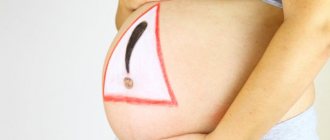As you know, labor pain has a wonderful property - it is quickly forgotten. Therefore, many women, remembering the birth of their child, only talk about how doctors “cut” them, as a result of which their life became more difficult in the first month after childbirth. As a rule, in this case we are talking about perineo- or episiotomy. We will talk about what these operations are, why they are needed and, most importantly, what a woman can do to avoid them or make these injuries less painful.
How is it happening?
The perineum is the bottom of the pelvis, it consists of muscles. During the birth process, the fetal head puts great pressure on them. As a rule, rupture of the perineum and vagina occurs with a cephalic presentation of the fetus. The outcome will depend on the elasticity of the muscles - whether they will be able to cope with the pressure and stretch so that the head passes. The muscles here become less elastic due to developed muscles and the woman’s age over 35 years. At the same time, the first birth is a threatening factor for perineal rupture.
At the same time, scars that remain after previous births or operations also increase the likelihood that such an unpleasant consequence will disturb the woman. Swelling during long labor also leads to this negative phenomenon.
There are descriptions of perineal rupture that occurred due to illiterate obstetric care. Thus, protection for a woman in labor during the delivery of the baby’s shoulders and head is not always provided, and this is an additional risk factor. The rapidity of the process also leads to a similar phenomenon.
Sometimes the very structure of the bones in the pelvis with a narrowed outlet suggests a future rupture of the perineum during childbirth.
Causes of ruptures during childbirth
No doctor can predict the occurrence of ruptures during labor, since even the absolute health of a woman and an easy course of labor do not guarantee the absence of injuries. Physiologically, the body is fully prepared for bearing and giving birth to a baby - tissues adapt and relax during contractions to allow the baby to pass through. But a number of factors can negatively affect the elasticity of the birth canal and cause trauma:
- inflammation of the reproductive system (in a chronic or acute state). These diseases reduce the elasticity of tissues, which become more loose, prone to bleeding, making them unprepared for significant stretching during childbirth;
- rapid labor (for primiparous women - less than 4 hours, for multiparous women - less than 2 hours). In this case, an early onset of pushing is observed. A short period of contractions may not be enough to fully dilate the cervix and sufficiently prepare the birth canal for the advancement of the baby;
- the presence of scars on the uterus and in the birth canal (after a cesarean section, previous births, removal of a tumor, etc.). Scar tissue is less elastic compared to healthy tissue, so often during childbirth, ruptures occur in the same place where they were previously, or at the site of sutures from surgical interventions;
- mature age of the woman in labor. After 35 years, the elasticity of tissues gradually begins to decrease, which increases the risk of injury if the first child is born at that age;
- swelling of the birth canal. It occurs during a prolonged period of pushing, as a result of weak labor, when the baby is in the birth canal in one position for a long time;
- tone of the pelvic floor muscles. This problem is relevant for professional athletes - gymnasts, equestrians, dancers. Inflated muscles are less susceptible to stretching, which complicates the process of the baby passing through the birth canal;
- large fruit. The large size of the baby determines an increased load on the tissues, which may simply not withstand the increased pressure and rupture;
- high crotch. This is a physiological feature that implies too great a distance from the anus to the vagina (more than 7 cm). With it, the tissues simply cannot stretch enough to let the baby through, as there simply aren’t enough of them.
A significant factor in determining the risk of birth injuries is the behavior of the woman in labor and the actions of medical personnel. Most often, births occur with ruptures in first-time mothers - many women are frightened by their feelings, do not know how to behave correctly, lose control and do not listen to the doctor’s recommendations. Panic and anxiety are the most dangerous companions in the delivery room, because of which the risk of severe ruptures increases significantly.
Also, ruptures can be the fault of the midwife who delivered the baby - her carelessness when removing the baby’s head and shoulders sometimes causes internal and external damage to the birth canal. Often the occurrence of injuries is associated with interference in the natural birth process - the use of forceps, a vacuum extractor, etc.
Varieties
Ruptures can be spontaneous, when everything happens due to the passage of parts of the fetal body, and violent - these arise due to the actions of obstetricians. There are three degrees of perineal rupture during childbirth.
The first degree manifests itself in damage to the posterior commissures and vaginal skin. The second is determined by muscle damage in the pelvis. In the third degree, there is a rupture of the sphincter of the anus, and sometimes the rectum.
Very rare, occurring in 1 in 10,000 cases, is considered a central rupture, when the vaginal walls, pelvic floor muscles and skin are affected, while the sphincter is not affected. The higher the degree of perineal rupture, the more difficult and longer the woman’s rehabilitation will be.
Complications
Swelling may subsequently appear at the site of sutures; this phenomenon is accompanied by pronounced pain. There are also purulent inflammations of the sutures, and the tissues can become scarred. Damaged areas may lose sensation and stitches may come apart. If any stage of the procedure was carried out incorrectly, the woman will ultimately suffer from uterine prolapse, and sometimes from its final prolapse. There may also be negative consequences in the rectum - incontinence of gases and feces will begin.
What is better - rupture itself or periniotomy?
Doctors try not to let the situation rupture.
The torn edges of the wound are more difficult to connect with each other, suppuration may appear over time, and their fastening may not be as precise. Therefore, when the doctor sees that a critical moment cannot be avoided, he makes a careful incision. This approach allows us to prevent the occurrence of undesirable consequences. Such edges are easier to join more accurately and with better quality.
Before stitching, the doctor assesses the condition of the wounds, sets the degree of severity, and from this decides which threads to use and which painkillers to inject. Using silk threads, the doctor warns that they will have to be removed in 4-7 days. But catgut or vicryl self-absorbing sutures do not require additional intervention. The advantages of a surgical incision are smooth edges, depth control, and some guarantee that it will not be prolonged arbitrarily.
Prevention
In order to prevent perineal rupture, you need to visit a gynecologist at least once a month, and do this more often according to his recommendations in different trimesters. It is important that a woman registers before the 12th week of pregnancy. Kegel exercises are believed to help avoid the consequences. Prevention will also be provided by massage performed on a regular basis from the 7th month of pregnancy. It is important that any inflammation of the genital organs that occurs is treated in a timely manner.
It is necessary to strictly follow all recommendations of gynecologists. Compliance with a diet before childbirth, which consists of reducing animal proteins in the diet and increasing oil, reduces the risk of subsequently needing suturing of a perineal rupture. It is important to learn in advance how to breathe properly and relax, and to prepare psychologically for the process.
Preventive measures
Some people believe that rupture during childbirth cannot be avoided. But that's not true. In fact, if you take certain preventative measures during pregnancy, the risk of injury becomes minimal.
Methods to deal with gaps:
Perineal massage. It is recommended to start it in the third trimester of pregnancy.
- Simple gymnastic exercises - for example, alternately moving the legs to the side or tensing the anal and vaginal muscles.
- Proper nutrition. Particular attention should be paid to vitamin E. It is found in fish, vegetable oil, and also in capsule form, available in any pharmacy. It is very important to avoid eating meat and any smoked products in the third trimester of pregnancy.
In progress
It is worth taking into account the fact that such a phenomenon is always preceded by a special condition - the threat of rupture of the perineum during childbirth. This is a direct indication for doctors to perform perineotomy or episiotomy. The threat manifests itself in swelling, cyanosis, the formation of cracks, and disruption of tissue integrity. Starting from the third degree, blood loss becomes simply massive. At any degree, there is a high risk of getting a bacterial complication.
Damage to the symphysis pubis
Normally, in a woman giving birth, the pelvic bones diverge due to the softening of the cartilage tissue under the influence of hormones. This process helps the baby to be born without tearing the soft tissue of the mother's genitals. Rupture of the symphysis pubis during childbirth is accompanied by severe pain when trying to lift the upper limbs, and with severe discrepancies, any movements cause pain.
The causes of violation of the integrity of the pubic cartilage are:
- rapid labor;
- large child;
- non-standard presentation and insertion of the head;
- use of forceps and vacuum extraction;
- lack of vitamin D, collagen, calcium and magnesium;
- narrow pelvis;
- skeletal development abnormalities.
A grade 1 pubic tear during childbirth on radiographs is characterized by a discrepancy of up to nine millimeters. At grade 2, this distance is 10-20 mm. In the third degree, the size increases by more than two centimeters, which requires surgical treatment.
Forecast
If all the rules are followed, the prognosis is most often favorable. As soon as the stitches are removed, pelvic functions will begin to recover. But as for the next pregnancy, this issue is resolved differently for each woman. In most cases, there are no contraindications to it.
If a 2nd degree perineal tear is not sutured for a long time, it begins to heal with infection. After all, this is an open wound that easily allows infections. As a result, the woman suffers from serious illnesses.
Subsequently, this will always manifest itself in a woman’s health - the pelvic floor will lose functionality, and internal organs will begin to prolapse. Often, an unsewn 2nd degree perineal rupture leads to inflammation in the uterus and the appearance of erosions. If the degree is third, incontinence of gases and feces occurs. As a result, the woman loses her ability to work and loses her position in society. For this reason, such a phenomenon must be eliminated in a timely manner. The sooner the surgery is performed, the better the result will be.
In cases where there is heavy bleeding, it must be addressed immediately. For this purpose, a large cotton or gauze swab is inserted into the vagina. It will absorb the blood as doctors apply stitches. After the procedure, the tampon is removed. It is important to ensure that the damaged areas are adjacent to each other tightly enough - this will speed up healing.
To ensure that the wound is exposed as much as possible, the vagina is further stretched during surgery and mirrors are used. If there is no assistant, the surgeon himself pushes the entrance with two fingers, revealing the wound. During the operation, he also pushes the edges of the wound apart with his fingers.
The rupture is always repaired under anesthesia. In addition to the fact that the patient is relieved of pain in this way, the wound opens to its maximum extent. This, in turn, gives the doctor maximum visibility. If the view is impaired, there is a risk that the skin or mucous membrane will be sewn up, and the muscles that have been torn will not be restored. In this case, the operation will only have a cosmetic effect. And all the consequences of a 2nd degree perineal rupture will affect later.
It should be taken more seriously if there is a third degree. In this case, it is necessary to connect the damaged sphincter. Otherwise the results will be unsatisfactory. To prevent this, a very thorough inspection is necessary. Often, during sphincter contractions, wounds disappear from view and become difficult to detect, especially if anesthesia is insufficient.
The suturing operation begins at the top, using needles to capture tissues that are located deep. As a rule, silk seams are used. But it is also possible to connect the edges using metal brackets.
If a 2nd degree perineal rupture is diagnosed, the upper angle of the damage is detected first. Usually it reaches all the way to the anus, its depth is such that it reaches the pelvic floor. As a result, entire cavities are formed in the depths of the damage, which are filled with blood. If there are several lateral tears, they begin to stitch them up one by one. If there is a 3rd degree rupture, the paravaginal and pararectal tissue is damaged. The first thing you need to do is connect the edges of the wounds in the rectum and in the sphincter: due to retraction, they sometimes go deep. Skin wounds must be treated with iodine, as well as the entire vagina, pubis, and folds in the groin. To prevent maceration of the skin and mucous membranes, this is done with sterilized Vaseline oils.
In addition to this, several sterile gauze pads are placed here. They are then replaced several times a day. It is important that the genitals are treated two to three times a day, as well as after each act of defecation, with potassium permanganate.
Enemas after this type of surgery are contraindicated. In cases where the patient does not have stool, she is prescribed the mildest laxatives on the second or third day. If recovery occurs as planned, the stitches can be removed after five to six days.
Rehabilitation period
In combination with vaginoplasty, the rehabilitation period lasts up to 2 months. The patient spends no more than 2 days in the hospital under the supervision of doctors. In the first days or weeks after perineal surgery, there may be pain, which can be relieved with painkillers.
- After discharge from the clinic, the surgeon gives you important recommendations for the rehabilitation period:
- Avoid physical activity;
- Avoid baths, saunas and being in a warm bath;
- Avoid sexual intercourse;
- Avoid sitting position.
Diet after surgery
If the rupture was grade 3, during the first five days after surgery the woman drinks only sweet tea, coffee with milk, broth, mineral water and juice. On the sixth day, the menu of such a diet is supplemented with applesauce and carrots. On the seventh day the patient takes a laxative, and on the tenth day the diet becomes normal.
It is important to consider that surgery must be performed for any rupture of the perineum, with the exception of only the smallest abrasions on the mucous membranes.
Often, in addition to the perineum, the labia and tissue at the vestibule of the vagina are also torn. As a result, severe bleeding occurs, as does pain. In this case, suturing is also carried out as soon as possible, using catgut sutures. If they are placed near the urethra, a metal catheter is inserted into it, and under its control the surgical operation takes place.
Sometimes, when the perineum ruptures, the skin of the perineum remains intact. While inside there is damage to the walls and muscles. Skin dissection is performed using the most conventional methods.
To ensure the best healing of tears, the woman is carefully cared for after childbirth. A number of obstetricians begin to wrap the external parts of the genital organs at least two to three times a day with gauze with potassium permanganate or boric acid. Afterwards the area is dried with powders. Some people advise not to touch the damaged area again, just keep it dry, only replacing the gauze pads.
Difficulties may occur in cases where the intestines are not completely cleaned before surgery. This happens often. If the intestines have been cleansed well, opium can be avoided. To prevent early bowel movements, it is advisable to take 10 drops of opium three times a day for the first 3-4 days. Someone avoids prescribing this remedy by prescribing Vaseline oil to patients one teaspoon three times a day.
If the rupture was incomplete, the patient is given laxatives on the third or fourth day, and the sutures are removed by the fifth or sixth day. She is discharged on the tenth day.
Caring for seams
While the woman is in the maternity hospital, the midwife monitors the condition and disinfection of the sutures. Treatment of seams is carried out twice a day with special antiseptic solutions (solution of brilliant green or potassium permanganate).
A woman’s task is to strictly adhere to the basics of hygiene:
- wash yourself every 2 hours and always after visiting the toilet;
- change gaskets regularly;
- wear underwear made from natural fabrics.
It is strictly forbidden to wear tight underwear after stitches, as it disrupts the blood circulation process and prolongs the healing time of the stitches.
After the operation, women are not allowed to sit down for several days (7 or more) - the period depends on the severity of the injury.
Warning in progress
In many cases, competent actions can prevent perineal rupture. So, it is necessary to slowly pass the fetal head through the vulva, cut through it as small as possible, slowly stretch the tissue, carefully observe how the shoulders are cut through, and remove them as carefully as possible. Compliance with such recommendations allows you to protect the perineum if the presentation is cephalic.
A major role in preventing such a negative phenomenon is assigned to the psychological and physical preparation of the expectant mother for childbirth. Preparation allows you to behave in a disciplined manner at the moment of expulsion, especially when the head is cut through. Often, surgery is used to prevent rupture. The surgeon simply cuts the perineum.
Some surgeons have proposed replacing the lateral incision, which is often used in this case, with a median one. D. O. Ott advocated perineotomy. He claimed that this helps prevent perineal rupture. In particular, if there were subcutaneous tears, he advised carrying out a similar procedure during any childbirth. But his point of view did not find approval in professional circles.
At the moment, perineotomy is performed on patients if, despite providing protection, there is still a threat that the perineum will rupture. An incision is made if the perineum has already stretched, become tense, thinned, or pale. In this case, the vulva is widened by 6 cm. Such a wound will be easily sutured and healing will occur quite quickly.
If the perineal rupture is already in the 3rd degree, this indicates that the birth probably occurred without medical assistance or due to excessively inept removal of the head using forceps. Sometimes this occurs due to the fact that the fetus was removed by the pelvic end. The prognosis becomes more favorable when there is a threat of perineal rupture if labor is anesthetized.
Reviews about ruptures during childbirth
Ruptures during childbirth are not uncommon, and they can occur under the influence of a number of factors: the woman’s unpreparedness, fear, inflammatory processes, weak labor, rapid labor, etc. It is impossible to completely eliminate this type of injury, but minimizing the risk is quite possible - for this you need carry out proper and comprehensive preparation for the upcoming visit to the maternity hospital.
Hello! My name is Alena, 25 years old. For many years I have been dealing with issues of family, health and raising children. I have a higher psychological and economic education. Rate this article: Share with friends!
Perineal incision
A perineotomy is an incision made in the perineum. There are several types of cuts. The choice is made by the doctor depending on the specific indications. Perineotomy is a less traumatic procedure than episiotomy.
Surgical intervention of this kind is carried out as soon as there is a threat of rupture or it has already begun. The thing is that a wound after a surgeon will heal much faster than one formed naturally. After all, the rupture leaves more noticeable and severe marks, and the danger of suppuration in this case is higher.
An incision is always made if it is important to complete the birth process as quickly as possible - when it is premature, there is fetal hypoxia or its development is abnormal. In this case, a gentle regime is necessary. If the efforts are weak, an incision is also considered a necessary procedure. It is also used if there are difficulties in removing the child’s shoulders.
And sometimes an incision is necessary because the mother has diseases - myopia, for example, or if she has undergone eye surgery, suffers from high blood pressure or has problems with the respiratory system. In this case, surgical intervention ensures her own safety. Complications after an incision are the same as with a rupture of the perineum. Although rehabilitation is much faster, it is still not easy. The woman will experience constant pain for the first few days. The sutures are removed on the fifth day. Constant care of the damaged area and regular treatment are important.
Perineoplasty result
Perineal plastic surgery will restore the aesthetic appeal of your intimate area and relieve you of the consequences of injuries and physical discomfort. Perineoplasty is a relatively simple operation, but it should be performed by an experienced intimate surgeon with the appropriate specialization. In our clinic, perineal plastic surgery is performed by qualified intimate surgeons with extensive experience. After the operation, you will be under the strict supervision of the medical staff of our comfortable hospital, so the risks of all kinds of complications are minimized.










